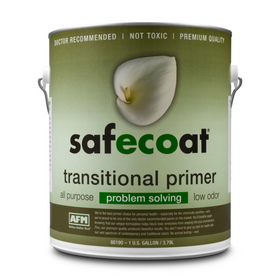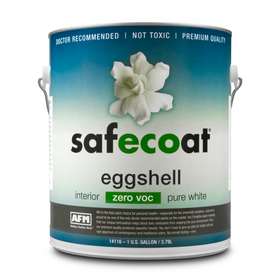
Lime-Based Paint: Add Color to your Home While Capturing Excess CO2
Last Updated: Feb 8, 2025Thanks to its CO2-absorbing properties, lime-based paint might be the healthiest and most ecological paint option for your home. We've written in the past about how lime mortar and related products have been shown to result in negative-zero (-2%) carbon emissions, making them an excellent alternative to portland cement.
In this article, we'll discuss how to use lime paint, the pros and cons, and what makes it so healthy and sustainable.
Table of Contents
- What is lime-based paint?
- What is lime paint used for?
- Is lime paint the same as chalk paint?
- Does lime paint absorb CO2?
- How do you apply lime-based paint?
- Is lime-based paint non-toxic and zero VOC?
- How long does lime paint last?
- What are the pros and cons of lime based paint?
- What are the best brands of lime based paint?

What is lime-based paint?
Lime-based paint offers the same environmental benefits as lime wash but with added durability. Lime paint is a full-bodied paint that is highly versatile.
For thousands of years, people worldwide have been using lime wash to paint the exteriors and interiors of their homes. Lime wash is slaked lime (usually in powdered form) combined with water to make a simple paint. Through a natural process, the lime is able to re-absorb carbon dioxide from the surrounding air during its carbonation process.
A lime wash can be used as the final coat of a wall or on heavily porous surfaces where you want the lime wash to absorb into the substrate. Unfortunately, lime wash is not very durable and will wash away with time. Because it tends to erode due to exposure to the elements, a simple lime wash will require a renewal coating every five to seven years. Furthermore, it is also important to only apply lime wash on overcast days to keep it from drying too quickly, which could cause cracking. When fully dry, lime wash may also rub off on your clothing.
On the other hand, lime-based paint offers the same environmental benefits as lime wash but with added durability. Lime paint is a full-bodied paint that is highly versatile. Unlike lime wash, lime-based paint has a higher viscosity or thickness of the paint. This is achieved by using authentic slaked lime, which is obtained by the action of water on lime, usually by soaking the lime in water for years on end. Other companies add other elements to the slaked lime to improve the viscosity and durability of the lime-based paint.
Graphenstone is one such company that has improved traditional lime paint by adding graphene fibers, which optimize its properties and give it durability. Graphene is made up of a hexagonal lattice of carbon atoms that is just one atom thick, which provides the paint with its extreme durability.

What is lime paint used for?
Lime-based paint can be used for both exterior and interior applications. In the past, lime wash was generally only used for building exteriors as it tended to rub off as it dried. Today, however, lime-based paint that incorporates other elements, such as graphene can also be used for home interiors.
Paint & Finishes
Score the ultimate combo of powerhouse paints and finishes, delivering performance with a side of family-friendly healthiness! Explore a vibrant variety sourced…

Vermont Natural Coatings PolyWhey Exterior Penetrating Wood Stain
Vermont Natural Coatings
In Stock
14 Colors

Vermont Natural Coatings Penetrating Water Proofer Infused With Juniper
Vermont Natural Coatings
In Stock

Vermont Natural Coatings PolyWhey Floor Finish
Vermont Natural Coatings
In Stock

Vermont Natural Coatings All-in-One Stain & Finish
Vermont Natural Coatings
In Stock
16 Colors

AFM Safecoat Transitional Primer
AFM Safecoat
In Stock

AFM Safecoat Dynoseal Roof and Foundation Sealer
AFM Safecoat
In Stock

Vermont Natural Coatings PolyWhey Furniture Finish
Vermont Natural Coatings
In Stock
3 Colors

AFM Safecoat Zero VOC Interior Paint - White
AFM Safecoat
In Stock

Vermont Natural Coatings Wood Cleaner
Vermont Natural Coatings
In Stock

Vermont Natural Coatings PolyWhey 3500 Wood Floor Finish
Vermont Natural Coatings
In Stock
Lime-based paints tend to be completely free from VOCs, carcinogens, and toxic substances, especially if they use mineral pigments for the color. As we mentioned above, when the lime is carbonating, it absorbs CO2 from the ambient air and cleans the air that you breathe. Lime-based paint, then, is a great alternative for people who want a healthy and environmentally friendly paint that purifies the air while also extracting excess CO2 from the atmosphere.
Is lime paint the same as chalk paint?
No. Chalk paint is a mineral-based paint used for home interiors that offers a matte finish with deep natural pigment colors. The chalky appearance creates an ‘aged’ look and easily be distressed. Chalk paint, however, is a latex, water-based paint. Though some chalk paints may include calcium carbonate, they also include other elements.

Does lime paint absorb CO2?
The main environmental advantage of using lime-based paint is that it can reabsorb the carbon dioxide emitted during the manufacture of slaked lime. Limestone is abundant worldwide, with crushed limestone making up 68 percent of all crushed rock produced in the United States in 2007.
Hydrated lime, or the quick lime used for construction purposes, is formed by burning sources of calcium carbonate (CaCO3), also known as limestone (or occasionally magnesian limestone). The burning process requires high temperatures between 850°C and 1200°C, which forces carbon dioxide out of the limestone (and into the atmosphere) to create calcium oxide (CaO, or quicklime). The calcium oxide is then slaked with water to produce calcium hydroxide eventually (Ca(OH)2) used for construction. While lime also requires burning in ovens at high temperatures, lime requires less energy to produce than cement due to lower temperature requirements.
While building lime does release carbon dioxide into the air during the burning process, lime products can absorb the carbon dioxide in the atmosphere through a process known as the lime cycle. The lime cycle begins when limestone is burned and releases CO2 into the atmosphere. The slaking process eventually creates calcium di-hydroxide, sold as a bagged lime powder. This can be mixed with sand or other coarse aggregate and water and used as a more natural mortar (and plaster) alternative. As the mortar hardens, it reabsorbs the carbon dioxide in the atmosphere and eventually re-hardens into limestone. Through this cycle, lime is widely considered a carbon-neutral building material, as it reabsorbs the carbon dioxide released during manufacturing.
According to Graphenstone, three 15-liter buckets of their lime-based paint can absorb more than 14.7 kg of CO2. Thus, one square meter of Graphenstone paint equals one tree's carbon sequestering capabilities.
How do you apply lime-based paint?
For the best results, you can do several coatings of lime-based paints. Applying the first coat at full strength, followed by diluted layers at a 1:1 ratio, can yield attractive results. Lime-based paint can be applied without a primer onto almost any medium, including brick, wood, stone, and plaster.
Lime-based paint can be applied to both exterior and interior walls. Like any paint, lime-based paints can come in dozens of colors. Graphenstone paints currently offer over 1,000 colors to choose from. With other lime-based paints on the market, you might be able to find products that come in different thicknesses. Because lime paint is full-bodied with a full viscosity, it can even be troweled onto the wall for thicker applications. You can also choose to dilute the lime-based paint to the level of wash you desire. Given the thickness you decide on, you can then choose to either roll, brush, or spray the paint onto your wall surface.

Is lime-based paint non-toxic and zero VOC?
Besides being good for the environment, lime-based paint is also great for your health. Most lime-based paints contain no volatile organic compounds (VOCs) or other toxic residues. It is best to choose lime-based paint brands that only use mineral pigments. In many cases, some paint brands that claim to be VOC-free or low-VOC do not take into account the VOC content of the synthetic pigments they use. When a lime-based paint is made of mineral pigmentation, it is almost certain to be VOC-free. Of course, as the lime-based paint carbonates on the wall, it will also pull excess CO2 from the surrounding air to even further purify the air inside your home.
How long does lime paint last?
Unlike lime wash, lime-based paints have extra viscosity and other added elements to help the paint better withstand the test of time. Graphenstone paints, by adding graphene fibers, significantly improve the durability of the lime-based paint. Graphenstone offers a product guarantee of five years, but in practice, the paint can be expected to last around ten years or longer.
The paint will gradually erode with a basic lime wash, especially with exterior applications and when exposed to the elements. Though this slow erosion can produce a gorgeous weathered look, homeowners wanting to maintain the original opaque coverage will need to reapply the lime wash every five to seven years.

What are the pros and cons of lime based paint?
Pros of Lime-Based Paint
- Made from a natural material
- Absorbs CO2 as it ages, leading to a “carbon negative” building solution
- Low to zero VOCs
- Highly breathable
- Naturally antibacterial
- Reduces your carbon footprint
- Improves your home´s indoor air quality
Cons of Lime-Based Paint
- Some lime-based paints may have VOC content due to synthetic pigments
- In the case of lime wash, you may have to reapply every 5-7 years
- Higher upfront cost
- Not easy to clean, and you may need to recoat if dirtied significantly
What are the best brands of lime based paint?
As more and more homeowners have begun to demand healthier and more sustainable paints for their homes, the demand for lime-based paints has grown. Today, there are several companies providing high-quality lime-based paints, including Graphenstone, Bauwerk Colour, JH Wall Paints, and Pure & Original.
- Graphenstone: This Spain-based company adds graphene fibers to its high-quality lime-based paint for one of the most durable and ecologically friendly paints on the market.
- Bauwerk Colour: This company was founded in Australia in 2000 and now ships its products worldwide. They specialize in making lime-based paint combined with clay, minerals, and beautiful natural pigments for a non-toxic and zero-VOC painting solution.
- JH Wall Paints: This company manufactures textured wall paint that can be used on interior or exterior surfaces. They also use natural earthen mineral pigments that refract light in a unique way.
- Pure & Original: This company sells a simple lime-based paint that is 100% mineral in nature, bacteria and fungus resistant, and also absorbs CO2 and nitrogen gases.
Lime-based paints offer a simple and straightforward way to create a gorgeous look for your home without the noxious VOC fumes and other toxic chemicals that have been lurking inside our paint products for too long. As an added benefit, lime-based paints will also help you reduce your carbon footprint by capturing excess CO2 from the atmosphere.
Tobias Roberts
Tobias runs an agroecology farm and a natural building collective in the mountains of El Salvador. He specializes in earthen construction methods and uses permaculture design methods to integrate structures into the sustainability of the landscape.
